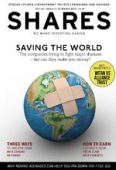Archived article
Please note that tax, investment, pension and ISA rules can change and the information and any views contained in this article may now be inaccurate.
Three ways to smooth your investment returns

Investing in equities can feel like a bit of a rollercoaster ride when stock markets are volatile.
Prices can swing wildly from one week to the next, causing even the most experienced investors to panic.
If you’re worried about the impact of market volatility on your portfolio, you might want to consider a ‘smoothing’ technique – where you aim for long-term, predictable and stable returns.
There are three main ways to smooth investment returns.
1. DIVERSIFY YOUR PORTFOLIO
Diversifying your portfolio means investing in a variety of assets that have contrasting responses to the market.
Rather than solely investing in equities, you spread your money across a range of other assets such as bonds, property, gold and cash.
‘Smoothing the combination of returns in this way reduces overall portfolio volatility without compromising on the exposure to higher risk assets,’ explains Kevin Doran, chief investment officer at AJ Bell.
An easy way to diversify your portfolio is to invest in a multi-asset fund.
‘Lots of people think about investment in terms of cash versus shares. They think they have a choice between the two, but funds vary enormously in terms of risk and reward,’ says Justin Urquhart Stewart, co-founder of asset manager Seven Investment Management.
Multi-asset funds offer a diversified mix of equities, bonds, alternatives and other assets that can smooth investment returns. You can choose the fund that best meets your risk profile.
Multi-asset funds usually have risk labels like ‘cautious’ or ‘adventurous’, but it’s always worth checking what the asset mix actually is.
‘A multi-asset fund is not about picking the winners, but about ensuring that the fund is reasonably well positioned for most investment environments,’ says Urquhart Stewart.
Another way of diversifying your portfolio is to invest in a ready-made portfolio that contains a range of funds or exchange-traded funds focusing on different asset classes.
2. INVEST REGULARLY
Investing a set amount of money each month can help to smooth the ups and downs of the stock market.
If you invest a large lump sum, there’s always the chance that a market tumble could be just around the corner.
By drip feeding money, you stagger your investments so if the stock market does fall you’ll only have invested some of your savings. Equally, your next monthly payment will benefit from the cheaper share prices available.
‘Investors are less susceptible to capital risk during short-term market volatility because losses are limited to the increment invested at a weaker price, as opposed to fully exposing a lump sum investment,’ says Doran.
‘Systematic investing reduces the risk of impulsive behaviour and potential losses that come with factoring in market timing, though lump-sum investments benefit from maximised compound returns and are fronted with fewer transaction costs,’ he adds.
Another advantage of regular investing is that even if you’re paying in small amounts each month, the money can soon start to build up.
This is because you benefit from the power of compounding – when investment returns themselves generate future gains.
If you invested £200 a month from age 20 until age 65, you could build a pot worth £402,444, assuming 5% investment growth after charges.
CONSIDER INVESTMENT TRUSTS
Investment trusts are a useful addition to long-term portfolios because of their ability to smooth dividend payouts.
Unlike open-ended funds, investment trusts can hold back up to 15% of the income they receive from companies each year. They can use these reserves to boost dividends when times get tough in the future.
‘This feature helps investment trusts produce consistently strong dividends and has contributed to their impressive dividend records,’ says Annabel Brodie-Smith, communications director at the Association of Investment Companies.
There are four investment trusts that have consecutively increased their dividends for over 50 years: Alliance Trust (ATST), Bankers (BNKR), Caledonia (CLDN) and City of London (CTY).
Brodie-Smith says investment trusts also offer a smoother ride because their closed-ended structure means managers can take a long-term view and sit out any market volatility.
‘Investment company managers don’t have to worry about inflows and outflows of investors’ capital, unlike managers of open-ended funds,’ she says.
An example of this came after the EU Referendum vote in June 2016, when many open-ended property funds had to suspend trading. Investors could not sell or buy the funds because the funds were unable to meet redemptions due to the illiquid nature of property.
Simon Edelsten from Artemis, manager of the Mid Wynd International Investment Trust (MWY), suggests investors look for investment trusts that are well-diversified, as this can help to reduce volatility.
‘A well-diversified global investment trust can be a useful core portfolio holding but be aware that investment trusts can trade at significant premiums and discounts in volatile times, which can help make a bumpy ride bumpier,’ he says. ‘Look out for those with policies in place to protect investors who want a smoother investment journey.’
It’s also worth looking at whether the trust uses a process called ‘gearing’ to boost returns. This is when the trust borrows money to buy shares it has a strong view on – with the hope of enhancing shareholder returns.
Brodie-Smith says that when applied sensibly, gearing enables managers to move more nimbly when they see a compelling investment opportunity.
But when the trust’s underlying portfolio underperforms, gearing can magnify losses. In general, the more an investment company gears, the higher the risk. (EP)
Important information:
These articles are provided by Shares magazine which is published by AJ Bell Media, a part of AJ Bell. Shares is not written by AJ Bell.
Shares is provided for your general information and use and is not a personal recommendation to invest. It is not intended to be relied upon by you in making or not making any investment decisions. The investments referred to in these articles will not be suitable for all investors. If in doubt please seek appropriate independent financial advice.
Investors acting on the information in these articles do so at their own risk and AJ Bell Media and its staff do not accept liability for losses suffered by investors as a result of their investment decisions.
Issue contents
Big News
- Impressive earnings ‘beats’ from service companies and engineers
- Barclays now in Edward Bramson’s cross-hairs
- What does Putin’s win mean for Russia-focused investments?
- FTSE 100 in a spin amid takeovers, restructures and spin-offs
- Is there more to come from Burford Capital?
- Pound see-saws on Brexit progress and softer price growth
 magazine
magazine









